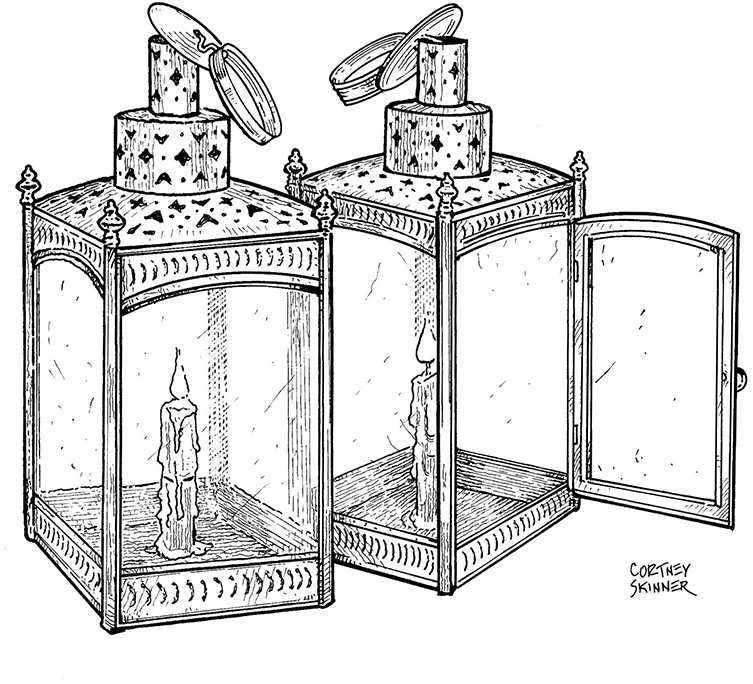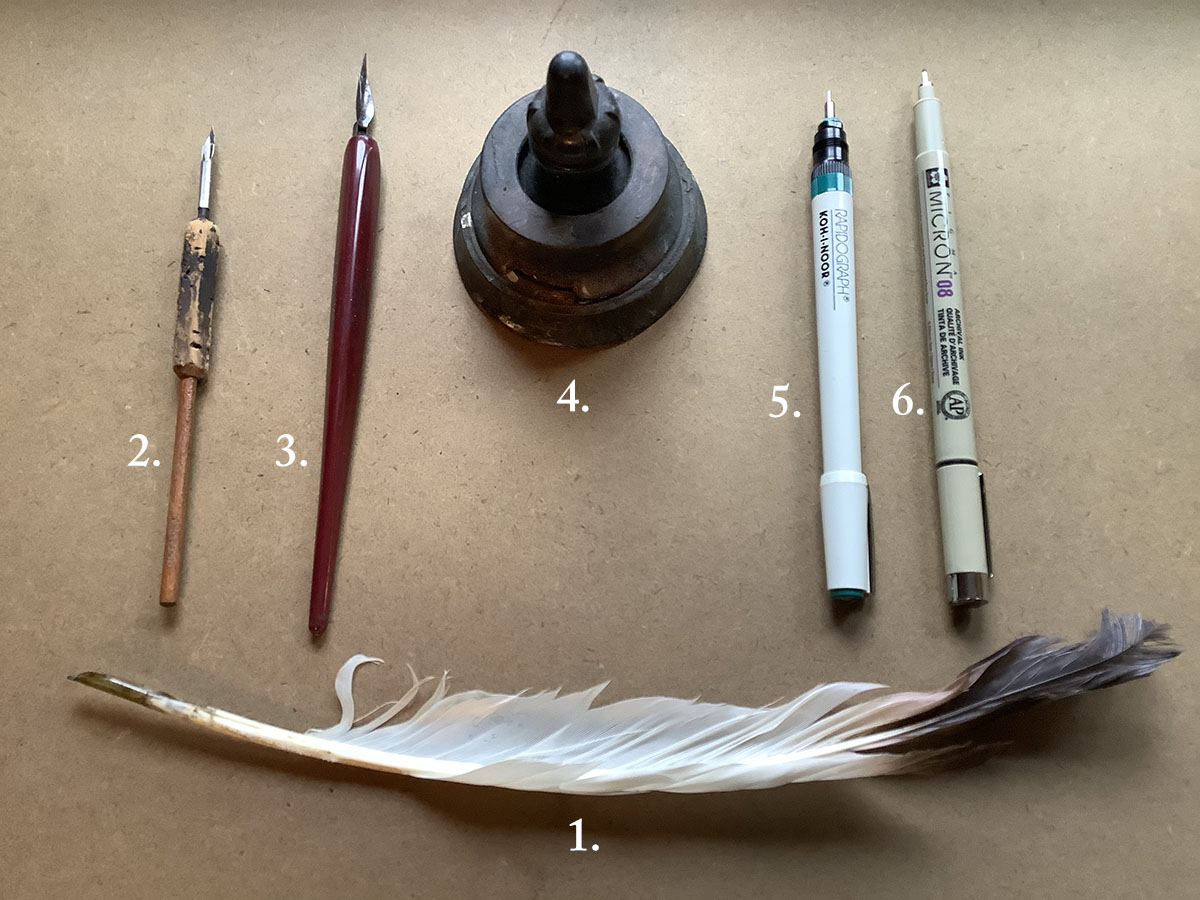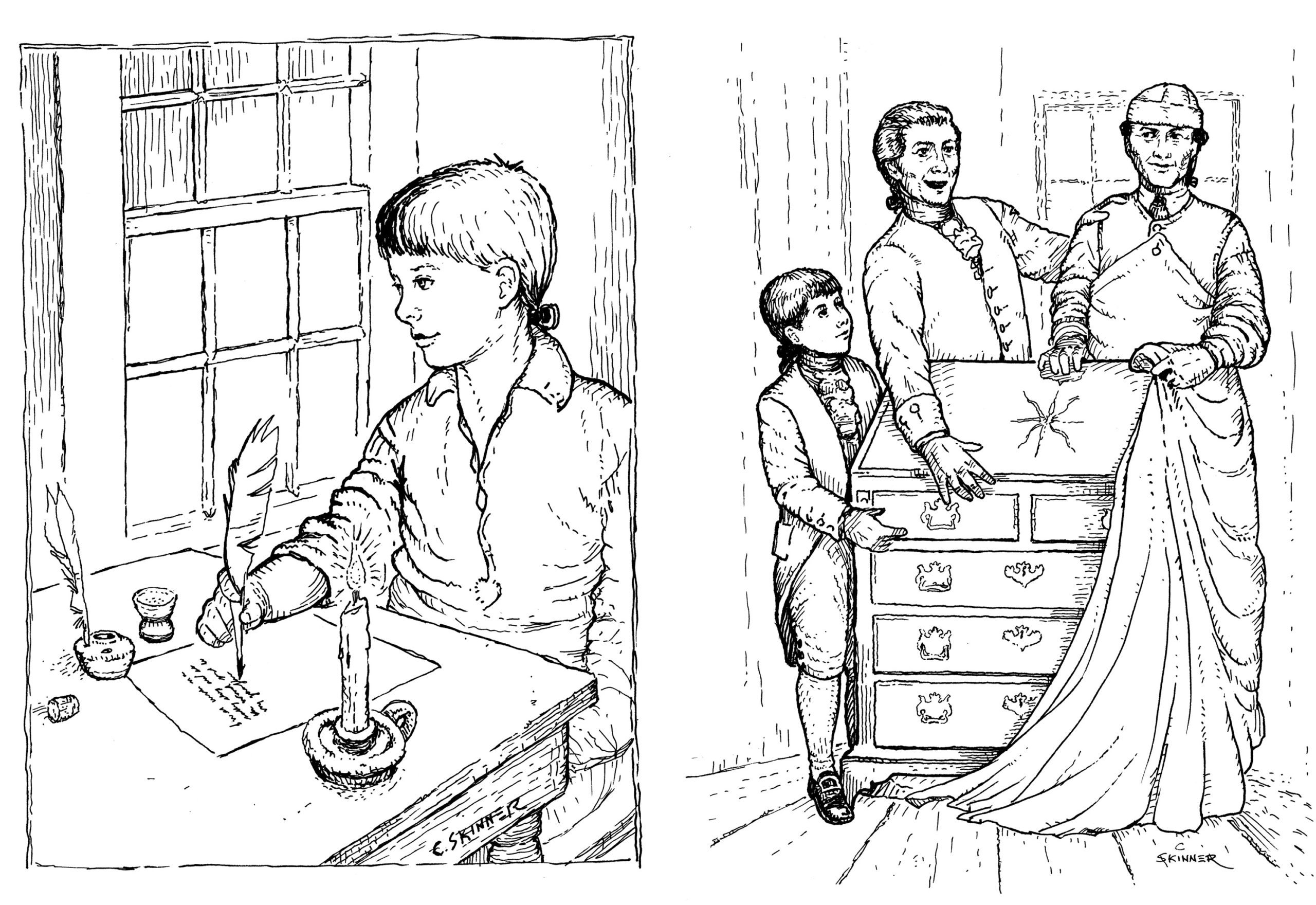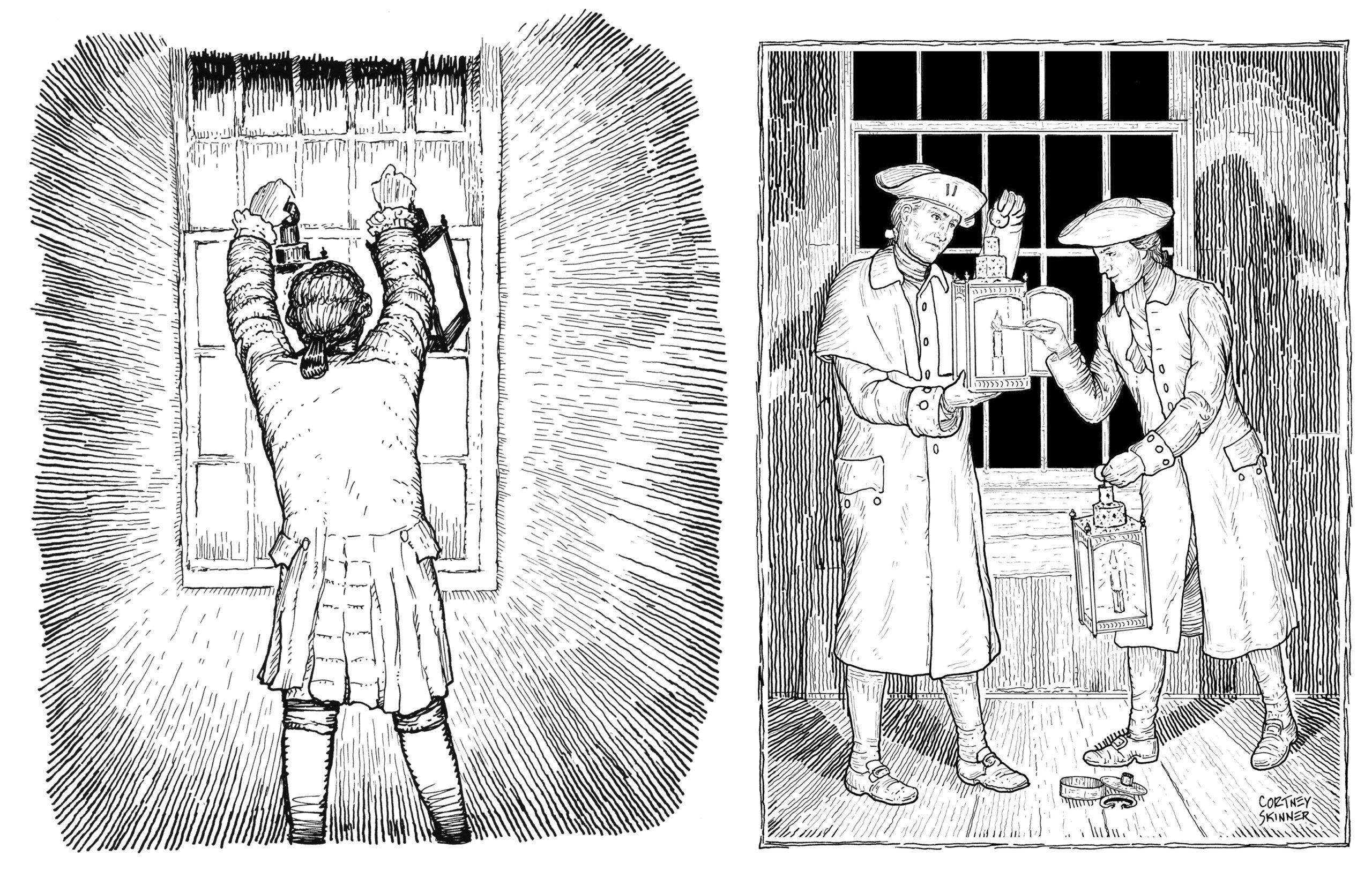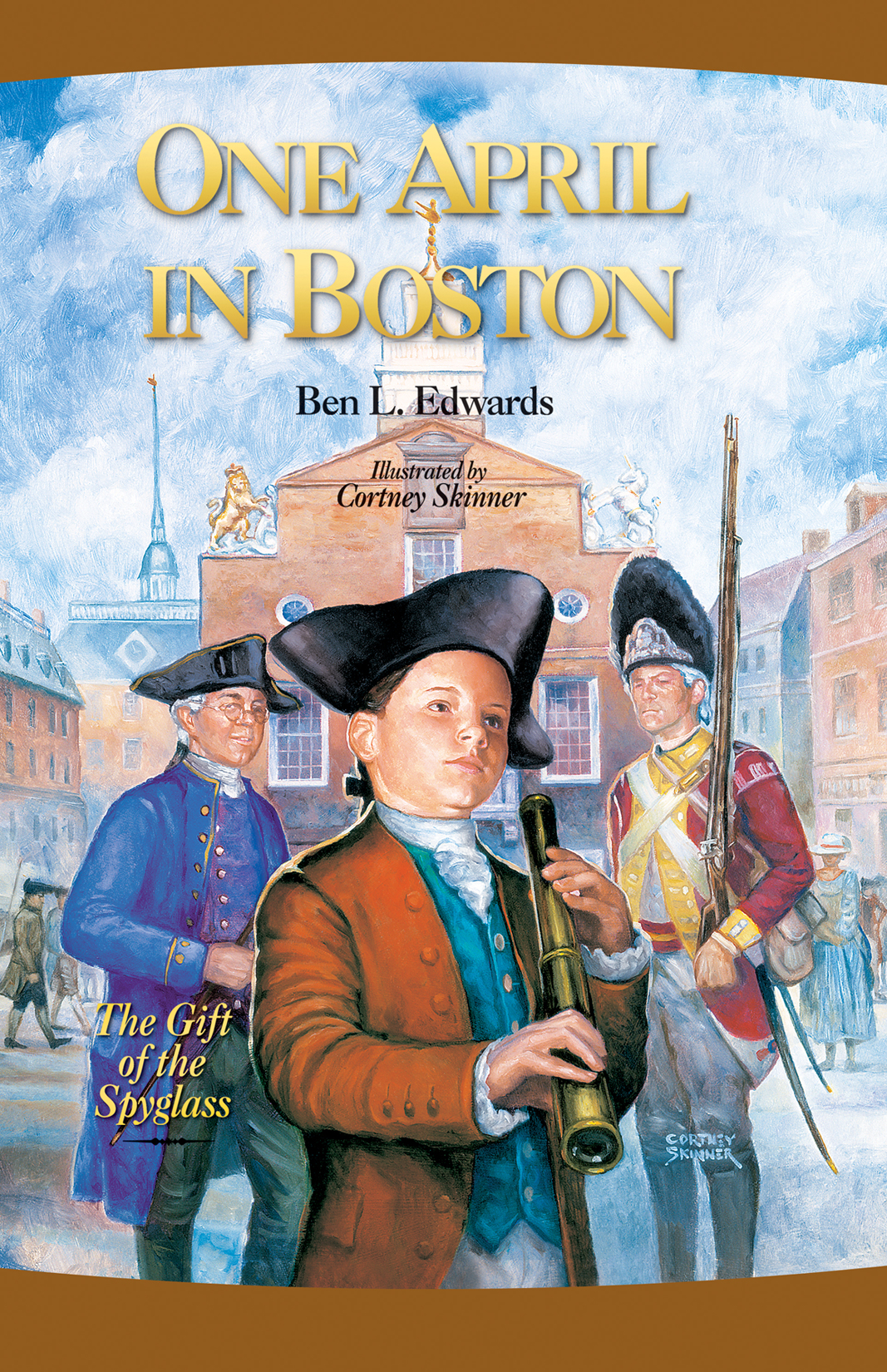One April in Boston
The Challenges of Pen and Ink Illustration
Creating the illustrations for the first edition of One April in Boston
by Cortney Skinner | 01.28.20
Before Ben Edwards approached me in 1999 with the project of doing pen and ink illustrations for One April in Boston, most of my commissioned illustrations had been paintings. I had created some pen and ink drawings for a science fiction book on dinosaurs, but delineating historic personages in linework called for a much different approach than drawing lumbering, scaly Stegosauruses.
Drawing in pen and ink is like walking a tightrope. Each step needs to be a mindful one. Once a line is on the paper, there’s no going back. You are committed. Corrections can be made but not without compromising the surface of the paper with either white correction paint or scraping the line off with a blade. Of course, when I began these drawings in 1999, there was no ability to digitally correct any mistakes.
Over time, I’ve used all the available tools for pen and ink drawing: a natural goose quill, a steel nib pen, a technical pen, and a graphic marker. Each has its advantages and drawbacks. You can see these drawing tools in the photo below. Using a goose quill—No. 1 would be a suitable historic choice, but it’s a high maintenance tool, requiring hardening the point with careful application of heat and keeping the point sharp with a blade.
Like a quill (without getting too much into the complexities), using a steel nib pen requires controlling exactly how much pressure to use in each stroke—which is a talent in coordination itself. Imagine having to be aware of how much pressure to use with each step of your feet when walking, and you’ll get an idea of some of the challenges of drawing with one of these tools. No. 2 is a steel nib pen used by my father about 75 years ago in his trade as an advertising artist. He was a very skilled penman. No. 3 is a steel nib pen that I’ve used in some of my illustrations.
Having to dip the pen in an ink bottle in order to reload it can create some interesting adventures in trying to keep one’s calm. No. 4 is a bottle of black, waterproof ink safely ensconced in a heavy metal collar (also used by my father) to prevent an accidental overturn and a flow of ink, artist tears, and expletives. Even with a spill-proof ink bottle, every pen and ink artist has had to deal with a renegade drop of ink leaving an over-dipped pen point and hitting the drawing at the worst possible place.
My choice has usually been the technical pen—No. 5. It allows control of the width of the line because every line width requires a different pen and point size. With technical pens, there are no spilling ink bottles; no wayward drips. I’ll hold four or five pens of various point sizes in my left hand in reserve as I draw with my right. However, these are high maintenance tools and preparing for a session of pen and ink drawing with these has sometimes required almost an hour of cleaning dried ink from the hollow tubes of the pen points in order to ready them for use.
The more recently developed technical graphic markers of different point sizes with archival ink are used by pro illustrators everywhere. No. 6 is just one brand of these. No cleaning. No maintenance. Just draw with them until the ink is used up. Those may be my next choice whenever the next pen and ink job comes up. Having a spill-proof tool that is ready to use without hours of cleaning a dried up, ink-clogged technical pen will save time and lower blood pressure.
I don’t pretend to be a virtuoso in pen and ink. It’s a difficult medium to employ even just adequately, and once one gets past the challenges of handling the tool, there is then the matter of deciding exactly where to place the lines in order to get the effect one wants. Each artist has his or her own style, much like their own personal handwriting. An artist’s style is dictated not only by their disposition and character and those second-by-second choices of pen strokes, but also by how their hand and wrist naturally move. It’s a totally Zen experience. The best pen artists glide through a drawing effortlessly (or make it look so). The others, like me, may labor through each stroke and try hard not to drive the pen into their heart in frustration.
None of my preliminary pencil sketches for the drawings in the first edition of the book have survived the twenty years and four relocations across and up and down the country, so I’ll display some sketches and get into that particular process in an upcoming blog post when I show examples from the second edition of the book. When drawing the characters in the book, I had no models with the exception of photographs of Mark Schmidt, serving as a model for Ben, and his sister Lynelle, who was my model for Betsey. Their photos at my elbow helped to keep their likenesses consistent. The two illustrations above feature Mark as young Ben. The first shows 10-year-old Ben at a small desk in his room putting his goals for the future into writing. The second depicts Ben with his uncles Alex and Ben admiring a desk that Uncle Alex, a cabinetmaker, recently completed.
I think that my pen technique evolved and improved in the 15 years between the first and second editions of the book as I got more comfortable with the medium. There was one instance where the updated historical narrative required a new drawing be made of a particular scene. Below, on the left, you can see the original drawing from the first edition of the book, showing Robert Newman holding the two lanterns aloft in the northwest window of Christ Church (Old North Church) to signal the movement of the British troops to patriots across the river in Charlestown. When the second edition of the book was planned, Ben Edwards wanted to give credit to Captain John Pulling Jr., for assisting Robert Newman in the task of displaying the signal, as that had become the accepted version of events. A new drawing was commissioned to illustrate that. By then, digital tools were also available. So I was able to make a separate drawing of the background and add that to the drawing of the figures of the two men so I could see if it was indeed a good choice for that background. The background was scanned and added to the foreground using Photoshop. That illustration appears below, on the right.
Ben Edwards faced another challenge when the Robert Newman narrative was changed. The audio book version of One April in Boston that was produced in 2001 also needed to be modified. Fortunately, award-winning narrator Phil Rosenthal, who had done the original reading 14 years earlier, was still available and remarkably his voice sounded virtually the same. Listen to the audio recording below to hear where the segment on Robert Newman and Captain John Pulling Jr. was edited in.
Two Lanterns
In my additional blog post, coming soon, on the basics of pen and ink drawing for One April in Boston, I’ll get a little more into the process of making a drawing, the choices made for the linework, and some of the techniques. The second edition of the book required more detailed research and illustrations of subjects from the 19th and 20th centuries as well. Most of those drawings were set in a small Connecticut town and in France during World War I. I particularly enjoyed the opportunity to create more illustrations of Philip Edwards, who has his ancestor’s spyglass in the second half of the story. The first edition only had 3 illustrations of Phil, while the second edition added 16 more.
Buy the Book Here
Direct from the Author
Paul Revere House - Boston
About This Blog
The Spyglass Blog was created to mark the 20th anniversary of the children’s book One April in Boston. Here the author and illustrator share the stories behind the illustrations, give insight into the artistic process, and introduce related artwork Ben Edwards shares on his Walking Boston private tour. SpyglassBlog.com
Subscribe
Receive notice by email when a new post has been added to the Spyglass Blog.
Meet the Author
Boston’s only private guided walking tour with a children’s book author and relative of Paul Revere. Details below.
Family Tours
Three private tour options. A fun and educational tour of the Freedom Trail your children will love! BostonFamilyTour.com
Field Trips
Field trips for the 2019-2020 school year are Sold Out. Booking now for the fall of 2020. BostonFieldTrip.com
Homeschool Groups
A unique field trip for homeschoolers that teaches your children American history and inspires them to create goals. Homeschool-FieldTrip.com
